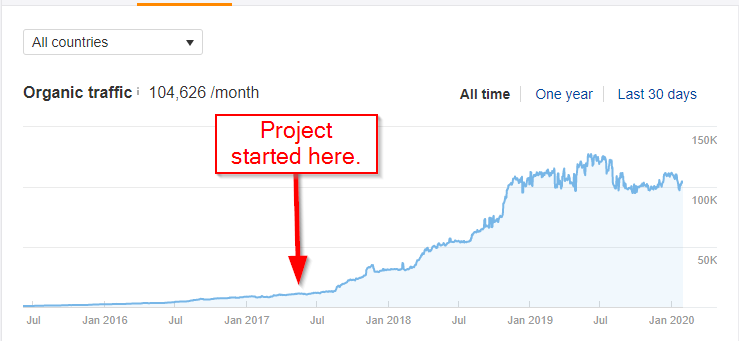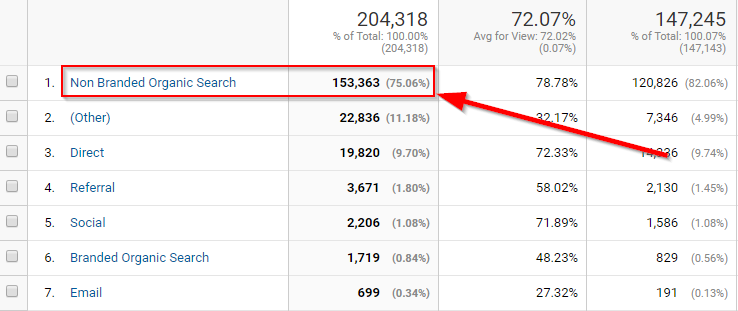…I get it.
This headline sounds fake.
I’m skeptical of claims like these too.
But this case study is legit―I have proof.
This is easily the best achievement so far in my SEO career.
I’ve helped other companies and bloggers see amazing results with content and SEO (as you can see in other case studies I’ve written), but none compare to the ridiculousness of this particular website.
But that’s not even the greatest part of this case study…
I’ve since used the framework from this client (with some tweaks) on every content-based SEO campaign I’ve ever run.
And it has increased traffic every single time.
That’s why I’m so excited to be writing this case study.
If you follow this simple (but by no means easy) process and stick with it, you WILL get more organic traffic.
I can’t promise it’ll be as ridiculous as the numbers I’m about to reveal, but you will start seeing more traffic.
Alright, enough hype…let’s dive in.
The Details…
I’ve worked with this client for about 3 years now. He’s a writing coach and author with a ton of credentials and experience.
When I started working with him, he got ~20,000 organic sessions and ~1,000 new email subscribers per month on average.
Which was great considering…
- His site was about 1% optimized for SEO
- He had 100s of unoptimized blog posts
- No intentional link building had been done
- No intentional internal link building had been done
- There wasn’t much of a strategy behind the content (from an SEO perspective)
- But because his content was so amazing, we knew his blog had massive potential.
Enter the SEO project…
4 Simple Strategies I Implemented to Increase Average Monthly Organic Traffic by 750%
1. A Massive Content Audit

I started by identifying all the best content assets on his blog from a traffic standpoint (with Google Analytics and Google Search Console). He had hundreds of blog posts, but only 10 of them got consistent traffic.
I removed and archived all blog posts that weren’t either driving organic traffic or getting consistent visits from his existing audience.
When I was done, 75% of his blog posts were gone. :0
What did I do with the rest?
I put each surviving post in one of two buckets.
1. Revamp, optimize, and republish: This bucket was for any existing content that had untapped potential. Content made it into this bucket if it:
- Had great keyword opportunities (high search volume and low organic competition) that it wasn’t ranking well for (if at all).
- Had unique insights and actionable steps for readers that could be expanded upon.
Only five posts fell in this category. I had the author add tons of content to each of these posts, along with new sections based on long-tail keywords.
Once we finished, I updated the publish date in WordPress and promoted it as a new post (but kept the same URL).
2. Leave the post as an unpublished draft and redirect: This bucket was for content that didn’t have much, if any, SEO potential.
Most of these posts were either written on very specific topics without much search volume or had content related to one of the content assets we kept.
If there wasn’t SEO potential for a post, I unpublished it and set up a 301 redirect to either a relevant content asset or the homepage. We kept these as unpublished drafts in WordPress so we could use the content for future posts. If the content of a post was very similar to one of our content assets, we added the content to the content asset and 301 redirected the post to the asset.
By the end of the content audit, he only had about 30 blog posts left (including those we revamped). But within a few months he was generating MORE traffic than he ever had before because every post on his blog was incredibly valuable and SEO-driven.
2. Creating New Strategic SEO Content Consistently
Alongside this audit, I worked with this client to develop ~2 new SEO-driven blog posts per month.
These posts were created to:
- Rank for keywords his target customers search in Google
- Provide incredible answers and solutions to those searchers’ questions and problems
- Capture email addresses by offering a highly targeted lead magnet
This kind of content is much different than what most people think when they hear “blog posts”.
It’s not written for your existing audience…
And it’s not written on any topic that happens to be in your head that day…
It’s super in-depth, highly valuable content targeting a specific group of keywords.
Since the Hummingbird algorithm update in 2013, you can rank a single piece of content for 1,000s of keywords. So we created 25 pieces of content over two years. Just a few months after each one was published, they all started ranking for hundreds, and some even thousands of different keywords.
One even ranked for 12,000 keywords…
And even with only 72 posts on his blog today (compared to the 100+ he used to have) he generates 150,000+ visitors every month from search:
Here’s the big thing you can’t miss when it comes to content: It really doesn’t matter how much content you produce and how often you produce it. What really matters is how valuable and optimized your content is, and that you produce it on a somewhat regular basis (whether that’s once a month or even once every other month).
This is a paradigm-shifting concept for many bloggers and business owners, but it’s powerful enough to sabotage your organic traffic if you ignore it.
If you’re interested in hearing specifics on how I create this content, click here.
And if you’re interested in hearing more about the general SEO content strategy I implemented with his brand click here.
3. Strategic Internal Link Building
Internal linking (especially for big, established sites) is an SEO cheat code.
It doesn’t take much time at all, you’re completely in control, and it can lead to massive results.
So, after I completed the content audit, I went through every page and blog post on this client’s site and added strategic internal links.
What does strategic internal linking look like?
A few things:
- Diverse but generally keyword-rich anchor text for anything you internally link to (so some that say “click here” or “more”, some phrases with secondary keywords, some phrases with variations of your target keyword, and a few phrases that include your exact keyword).
- Using pages with the most backlinks to boost the authority of pages you want to rank higher.
- Intentionally sending visitors to certain relevant pages (this might be a landing page, lead magnet opt-in, service, product, etc.)
The strategy I used for this client was simple. Add 5-10 internal links to every blog post using anchor text that included either:
- The target keyword of other posts
- A variation of the target keyword
- Or a secondary long-tail keyword
Simple enough, right?
As I did this, I found two options for doing this as fast as possible (because let’s be honest, this takes a whole lot of monotonous screen-staring hours if you’re going through 50+ posts):
1. Go through each post in your CMS in order of publication date adding internal links.
If you decide to go this route, it helps to have a spreadsheet open with links to all of your blog posts so you can add internal links as you scan the content. Simply go through each blog post looking for good anchor text opportunities, then copy/paste links as you see fit. If you don’t have great anchor text opportunities, you can always tweak the content.
2. Use the search bar in your WordPress admin for certain phrases and add internal links to posts containing those keywords.
Here, you can search target keywords, long-tail keywords, and LSI keywords in your WordPress dashboard to find posts that already have those phrases.
Then, all you have to do is go through those posts and add internal links (repeating this process for every post on your blog).
4. High-Quality Link Building
Finally, while all this was happening, I was building links in the background to all his existing SEO assets along with the new ones I helped him make.
But instead of focusing on quantity, I focused on quality.
In the SEO world, quality = relevant, high domain authority, natural links.
So, I only went after link opportunities from sites that were related to or talked about writing and also had a Domain Rating in the 30+ range.
This means I had to convince other bloggers in his niche to link to him.
At first, I followed exactly what “experts” told me to do in blog posts I read. I even used their pre-written templates.
When that didn’t work, I started testing new angles.
I even started offering free access to courses and membership sites from my author regardless of whether someone added my link or not.
And over time, I realized something: If you have outstanding content, reach out to someone who’s already linked to or written similar content, and offer them exceptional value, you’ll see incredible conversion rates.
I won’t lie..it wasn’t easy, and it took a long time to find the right formula.
But after sending 1,000s of highly targeted outreach emails, getting guest posts on sites like Writer’s Digest, and creating long-term partnerships with other writing sites over the last 3ish years, my client not only ranks in the top 3 for some of the most competitive keywords in his niche, but he also has tons of new relationships and affiliate opportunities with other sites.
On top of that, since we built links the right way, he’s not at high risk for a manual penalty that could tank his traffic.
Every algorithm update in the past 3 years has either helped his traffic or left it untouched.
The Results…
After implementing these strategies for this client for ~33 months now, I’ve been able to increase his average monthly organic traffic from ~20,000 to ~150,000 sessions as of the time of this writing.


Note: This is an Ahrefs screenshot. They estimate search traffic based on their data but in my experience it’s never completely accurate. So, here’s a screenshot of traffic from the last 30 days…

Because of this traffic lift and some conversion rate optimization, I was also able to increase his average new email subscribers per month from ~1,000 to ~5,800.
The great thing about this case study is the principles behind the strategies I implemented can help nearly every site in any niche get more traffic.
You might not see ridiculous numbers like this, but when implemented correctly, you WILL see more organic traffic.
And watching qualified traffic and leads fall into your lap every day is a beautiful thing. 🙂
Want Us to Do This for You? Get a FREE Website Analysis
Grab a spot on my calendar below to schedule your FREE 30-minute website analysis where we’ll jump on a call and show you:
- The biggest low-hanging fruit opportunities we see for increasing your traffic and leads within as little as 30 days
- How we recommend implementing the strategies discussed in the training for your specific situation
- And answer your questions about ranking and growing your blog as a marketing channel (we usually charge for this!)
Ready to Scale Your Business?
Want to chat about how we could work together to grow your business? Click the button below to book a call.